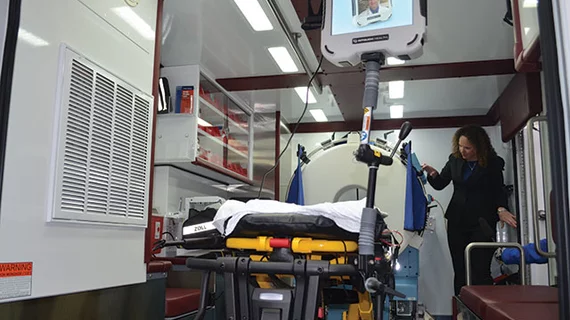CT-based Mobile Stroke Care
Germany's ground-breaking use of CT scanners in ambulances to assess for possible stroke inspired one program in Houston to follow suit. Supporters predict it will transform care in the future.
For 30-year-old Maureen Osaka, the first signs of stroke were dizziness followed by numbness in her left side. She was experiencing a basilar artery occlusion, a brain stem infarct with a mortality rate greater than 50 percent. Many patients with this type of stroke won’t make it to a hospital for treatment, and those who do survive often face lifelong severe disability.
Thankfully for her, a local stroke center in Houston had a new tool at its disposal: the Mobile Stroke Unit. The unit is the first of its kind in the U.S., a specially equipped ambulance with a CT scanner able to quickly assess patients and, if appropriate, speed the delivery of tissue plasminogen activator (tPA) to bust the clot. It was created in a partnership between the University of Texas Health Science Center at Houston (UTHealth) Medical School and Memorial Hermann-Texas Medical Center (TMC).
"We in the stroke community have always known treating a patient faster is better and that the major difference for stroke from other conditions is that we have to have that brain image before we can treat the patient,” says James C. Grotta, MD, the neurologist at Memorial Hermann-TMC who spearheaded the project. “We have always dreamt of doing that imaging pre-hospital.”
The window for tPA administration is brief, up to four and a half hours, depending on the patient. When the mobile stroke unit team arrived to treat Osaka, they confirmed the stroke using the onboard CT and began administering tPA on site—78 minutes after she first felt sick, according to Grotta. Days later she was back home, speaking and moving without deficit.
Mobile Stroke Unit Inspired by Berlin
The mobile unit in Houston came about after Grotta visited Germany in 2012 and observed a similar project in Berlin. There, researchers were conducting the Prehospital Acute Neurological Treatment and Optimization of Medical Care in Stroke Study (PHANTOM-S), in which the Stroke Emergency Mobile (STEMO) unit was dispatched to treat suspected strokes. Like the UTHealth mobile unit, STEMO is equipped with a CT scanner, point-of-care laboratory capability and telemedicine connectivity.
In coordination with the Berlin Fire Brigade, STEMO was dispatched 1,804 times over a 21-month period from 2011 to 2013, being utilized every other week so that treatment times could be compared against the use of conventional ambulances (JAMA 2014;311[16]:1622-1631). Some 177 patients were treated with tPA in the mobile stroke unit, and the intervention boosted treatment rates for ischemic strokes from 21 percent to 33 percent. STEMO allowed for a 25-minute reduction in time from alarm to tPA treatment, and 58 percent of patients were treated within 90 minutes of symptom onset compared with 37 percent in the control group.
Lead author of the study, Martin Ebinger, MD, of the neurology department at Charité–Universitätsmedizin Berlin, says STEMO reduced alarm-to-thrombolysis time without increasing risks. There were no CT malfunctions and the experience established the feasibility of telemedicine consultations on board a mobile stroke unit, though the reliability bar for connectivity necessarily must be set high and needs further testing.
“In these emergency situations you are looking for a reliability that is as close as possible to 100 percent,” says Ebinger. “With advancing technology, this goal is no longer out of reach.”
After seeing the positive results firsthand in Berlin along with an earlier study from Klaus Fassbender, MD, and colleagues in Homburg, Grotta and colleagues started raising money for the UTHealth mobile unit in early 2013. While STEMO used a much larger, specially designed ambulance, the project in Houston modified a standard 12-foot ambulance. The ambulance itself cost upwards of $150,000, the CT scanner nearly $400,000, and tens of thousands of additional dollars went into build-out expenses to accommodate the CT scanner and telemedicine connectivity.
Takeoff of mobile stroke unit in Houston
But simply building a mobile stroke unit is only half the battle. There are also a number of bureaucratic hurdles in front of a project with this scope. "It's like starting a business from nothing," says Stephanie Parker, RN, BSN, project manager for the UTHealth Mobile Stroke Unit. Parker says protocol guidelines must be very specific for patient care and the ambulance must be equipped for every scenario. The unit is run in conjunction with several fire departments, and establishing communication with the various departments is key. Contracts and licensing must be squared away for each city, and Parker says she communicated with as many as seven different sets of lawyers.
So far, the mobile unit demonstrates some speedy treatment times. “We can have [patients] scanned with the CT scanner, the labs completed and the patient's treatment started ... at between 18 and 22 minutes of being on scene," she says.
Since it began responding to calls in May, Grotta says the mobile unit has treated about two patients per week and transported about four patients every week. A trial is currently being conducted that will look at whether telemedicine can reliably be used to assess a patient so that a neurologist need not be present in the vehicle.
The program offers potential savings that offset costs, Grotta says. "It'll save hundreds of thousands of dollars to the healthcare system for each patient who improves as a result of earlier treatment."
Besides costs, other questions remain. The trial that originally evaluated tPA did not determine whether extremely fast treatment within 80 minutes results in better outcomes, something Parker hopes the Houston project will be able to show. There’s also the question of whether a mobile unit like this can be effective outside of an urban setting. “The whole scenario of pre-hospital thrombolysis in acute ischemic stroke is still so new that many aspects can only be speculated on,” says Ebinger.
The questions echo the discussions that occurred when tPA was first tested, as emergency department (ED) administrators fretted about the costs of having stroke specialists on hand and CT scanners located in the ED. These things are now routine, and stroke care was one of the driving forces.
"In my opinion, 10 years from now, CT scanners or some other imaging capability will be routine on ambulances, not just for stroke, but for other conditions,” says Grotta. “It will become very useful to be able to image patients in the pre-hospital environment and to have telemedicine on board ambulances so that physicians at the hospital can tell what's going on in the field and get treatment started a lot earlier."

